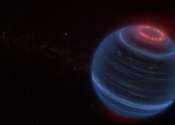A gas giant (sometimes also known as a Jovian planet after the planet Jupiter, or giant planet) is a large planet that is not primarily composed of rock or other solid matter. There are four gas giants in our Solar System: Jupiter, Saturn, Uranus, and Neptune. Many extrasolar gas giants have been identified orbiting other stars.
Gas giants can be subdivided into different types. The "traditional" gas giants, Jupiter and Saturn, are composed primarily of hydrogen and helium. Uranus and Neptune are sometimes considered a separate subclass called ice giants, as they are mostly composed of water, ammonia, and methane; the hydrogen and helium in Uranus and Neptune is mostly in the outermost region. Among extrasolar planets, Hot Jupiters are gas giants that orbit very close to their stars and thus have a very high surface temperature; perhaps due to the relative ease of detecting them, Hot Jupiters are currently the most common form of extrasolar planet known.
Gas giants are commonly described as lacking a solid surface, although a more accurate description is to say that they lack a clearly-defined surface. Although they have rocky or metallic cores - in fact, such a core is thought to be required for a gas giant to form - the majority of the mass of Jupiter and Saturn is hydrogen and helium. In the planet's upper layers, these elements are gaseous, as they are on Earth, but further down in the planet's interior, they become compressed into liquids or solids, which become denser toward the core. Similarly, although the majority of Uranus and Neptune is icy, the extreme heat and pressure of these planets' interiors put the ices into less familiar physical states. Therefore, one cannot "land on" gas giants in a traditional sense. Terms such as diameter, surface area, volume, surface temperature, and surface density may refer only to the outermost layer visible from space.









